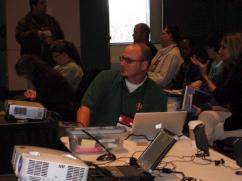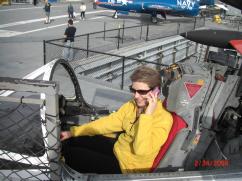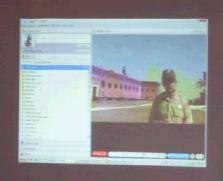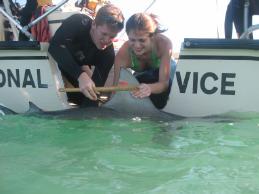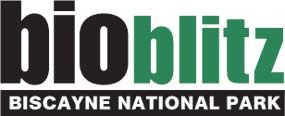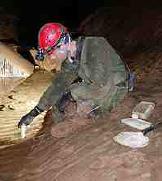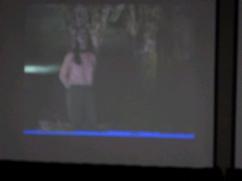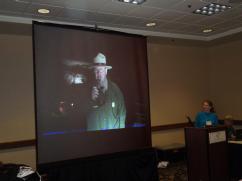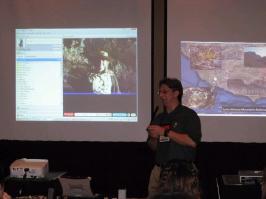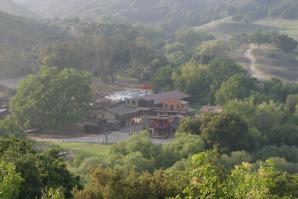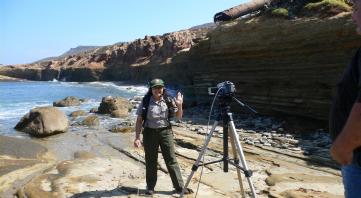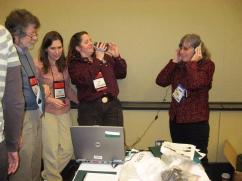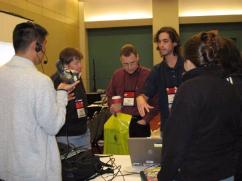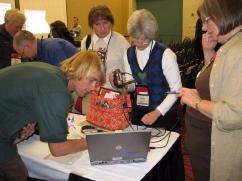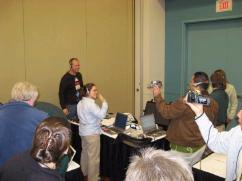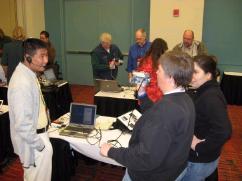
|
|
|
|
December 25, 2009
Third Sea to Shining Sea Live Interactive Virtual Explorations workshop held in Connecticut By Susan Teel, Director,
Southern California Research Learning Center,
National Park Service
 The third Sea to Shining Sea (StSS) Live Interactive Virtual Explorations (LIVE) workshop was held on November 19, 2009 at the National Park Service's National Association for Interpretation (NAI) annual conference in Hartford, CT. The event was hosted by:
In preparation for the StSS LIVE workshop, Jim Hale and Hans-Werner Braun provided long distance support from California by testing and trouble shooting the LIVE systems at each of the five National Park Service sites. Pablo Bryant (San Diego State University), Evan Locke (SCRLC), and Joe Zev (SCRLC) prepared 20 backpacks, demonstration equipment, and tested Internet connectivity at NAI to ensure success at the NAI site in Hartford.
Demonstrations The session consisted of a ten-minute LIVE session at each of five National Parks across the United States. During each LIVE session, audience members interacted with the Rangers and requested various views of each park. The goal was to demonstrate the ease of use and mobility of the LIVE backpack distance education system, developed by HPWREN. The majority of audience questions related to the LIVE equipment and set-up. The LIVE backpack equipment list and instruction manual is available at: /20081113_NPS-TT-Workshop/Kimberly_Mann_Bruch/. Dry Tortugas National Park The first demonstration was begun by contacting Ranger Chris Ziegler at Dry Tortugas National Park, the most remote National Park Service (NPS) site in the continental United States. This park consists of seven small islands located approximately 75 miles from Key West, Florida and about 92 miles from Cuba. Therefore, the ability to conduct LIVE programs at this most remote NPS site demonstrates that the techology is viable to expand towards similar LIVE programs at any of the other 390 NPS sites.
Biscayne National Park The second demonstration was to be hosted by Biscayne National Park and South Broward Maritime Magnet Program, however a lightning strike a few days before the workshop burned out the radios. Park staff was not able to complete repairs in time for the NAI conference. High School students built a remotely operated vehicle and planned to use it to explore the coral reef nursery at Adam's Key, a small island eight miles off-shore.
Biscayne Bioblitz LIVE April 30 to May 1, 2010
Biscayne National Park will host Bio-Blitz 2010 and use multiple LIVE programs to engage citizen scientists across the nation in 24 hours of inventory activities both underwater and on land. HPWREN continues to provide technical expertise to the NPS and National Geographic Society towards planning and installing a wireless network at Biscayne National Park. This system will support underwater LIVE programs broadcast from a boat at multiple locations throughout the park and from the islands of Adams Key, Elliott Key, Boca Chita Key as well as the mainland. Mammoth Cave National Park NAI participants next explored the dark depths of Mammoth Cave National Park. The lights at the workshop were dimmed and audience members audibly gasped when, Shannon Trimboli, appeared in Mammoth Cave. NAI attendees quickly requested that the video be enlarged to full screen so they could better see the details in the cave. Shannon and Rick Toomey, Mammoth Cave International Center for Science and Learning, hosted the underground session and moved around the cave showing various cave features.
Santa Monica Mountains National Recreation Area
Cabrillo National Monument
The video quality at Cabrillo was quite noticeably better than the other sites, due to the connection to HPWREN which provides high bandwidth Internet connectivity. Unknown to the audience, during the demonstration the access point failed. We later learned that Jim Hale, HPWREN, had patched together the faulty access point ensuring superior video quality from San Diego. LIVE Workshop
Twenty backpack sets were made available for workshop participants to borrow and try out. Participants began the hands-on portion of the workshop and familiarized themselves with the LIVE backpack equipment. Attendees formed groups of 2-3 people, reviewed the LIVE manual and assembled their backpacks. In less than 30 minutes most groups had initiated LIVE sessions with Dry Tortugas, Cabrillo National Monument, Mammoth Caves, or Santa Monica Mountains. Evan, Joe, and Ranger Rick assisted participants in assembly of the LIVE backpack and conducting their first LIVE program.
Workshop evaluations, which were submitted to HPWREN, were all quite positive with many compliments for the StSS team. Some of the comments received included:
If we plan another workshop, it might be valuable to use technology implementations such as Polycom, Skype, and Elluminate to show a spectrum of video quality and options for point-to-point and point-to-multi-point video conferencing. Thanks to all of our Sea to Shining Sea partners for another successful LIVE workshop. |
